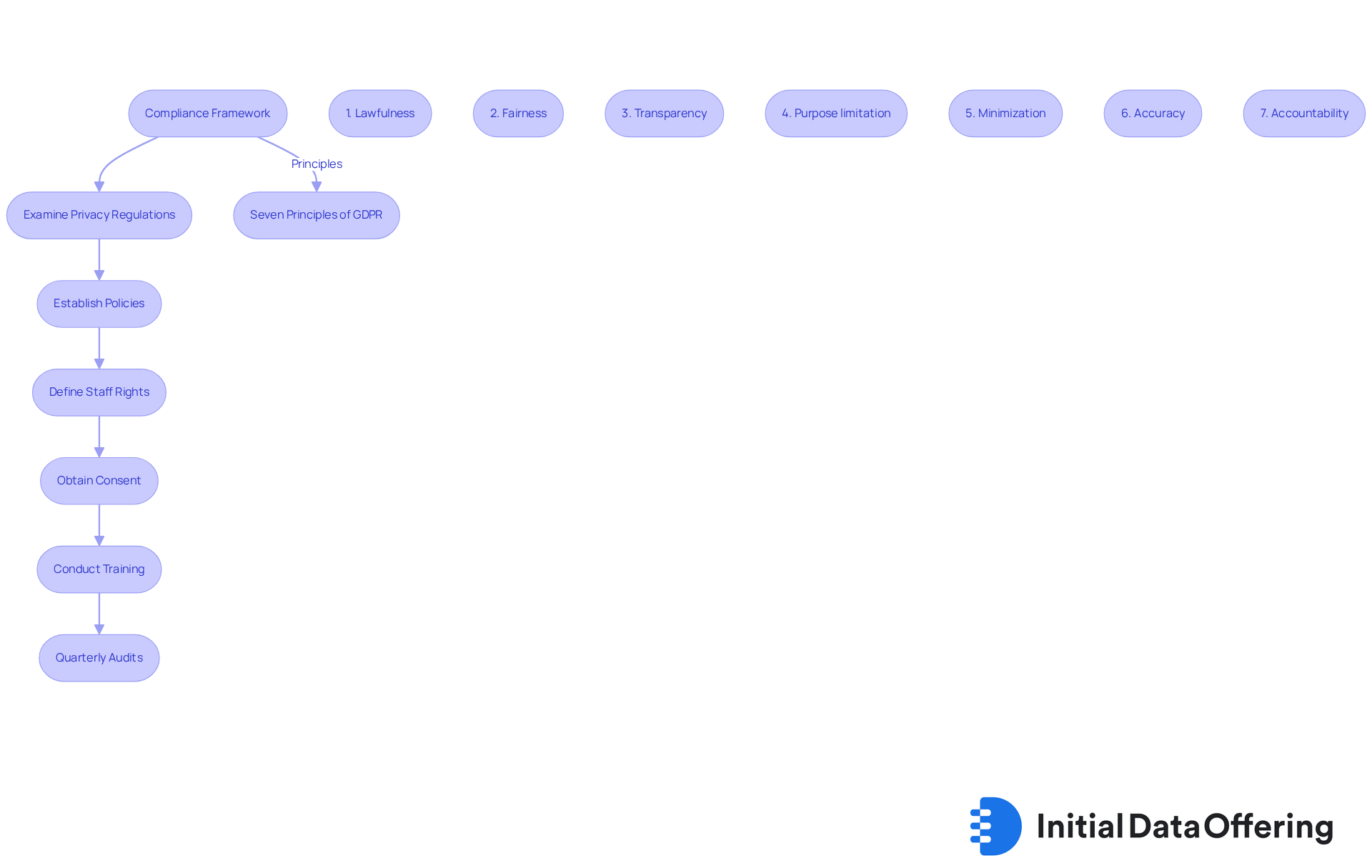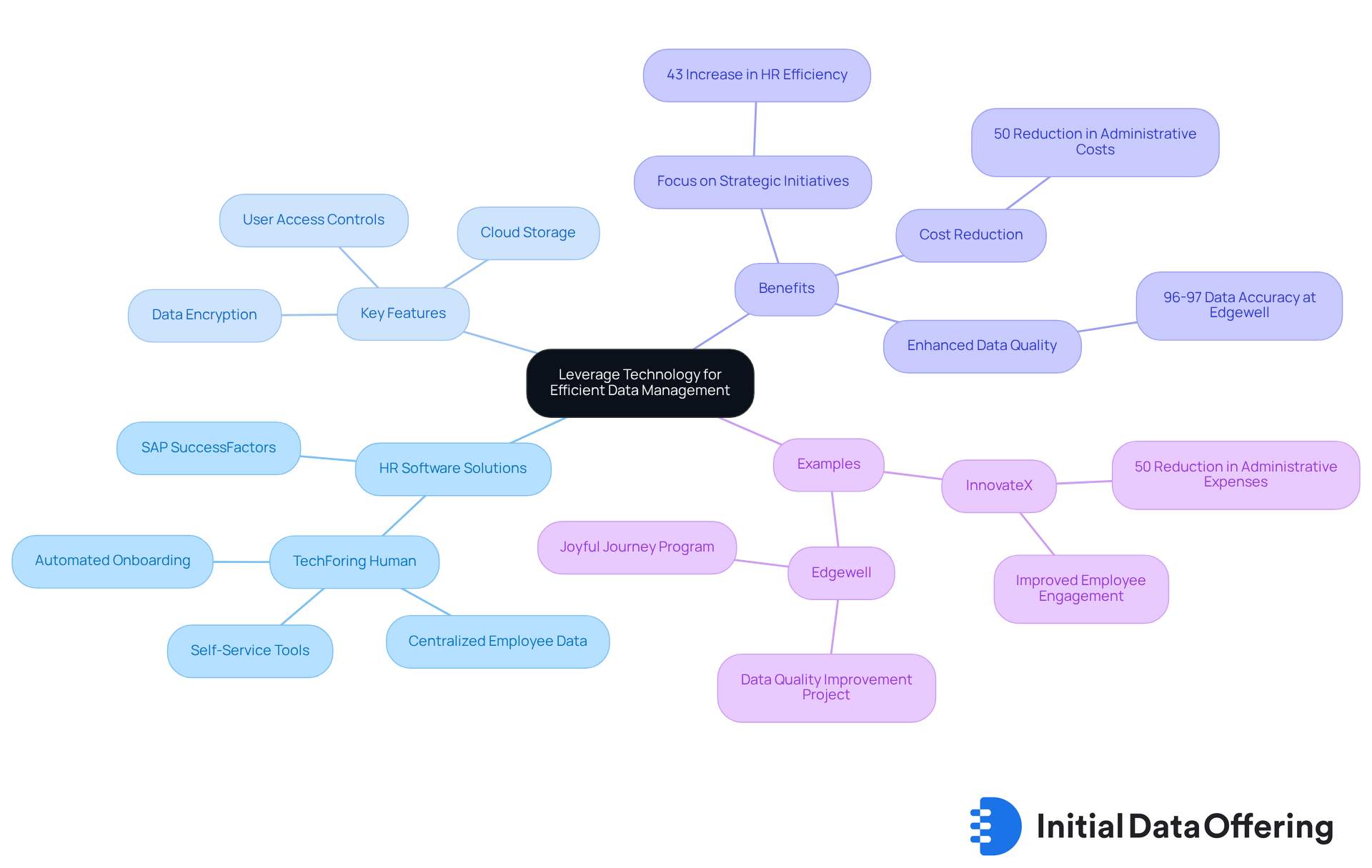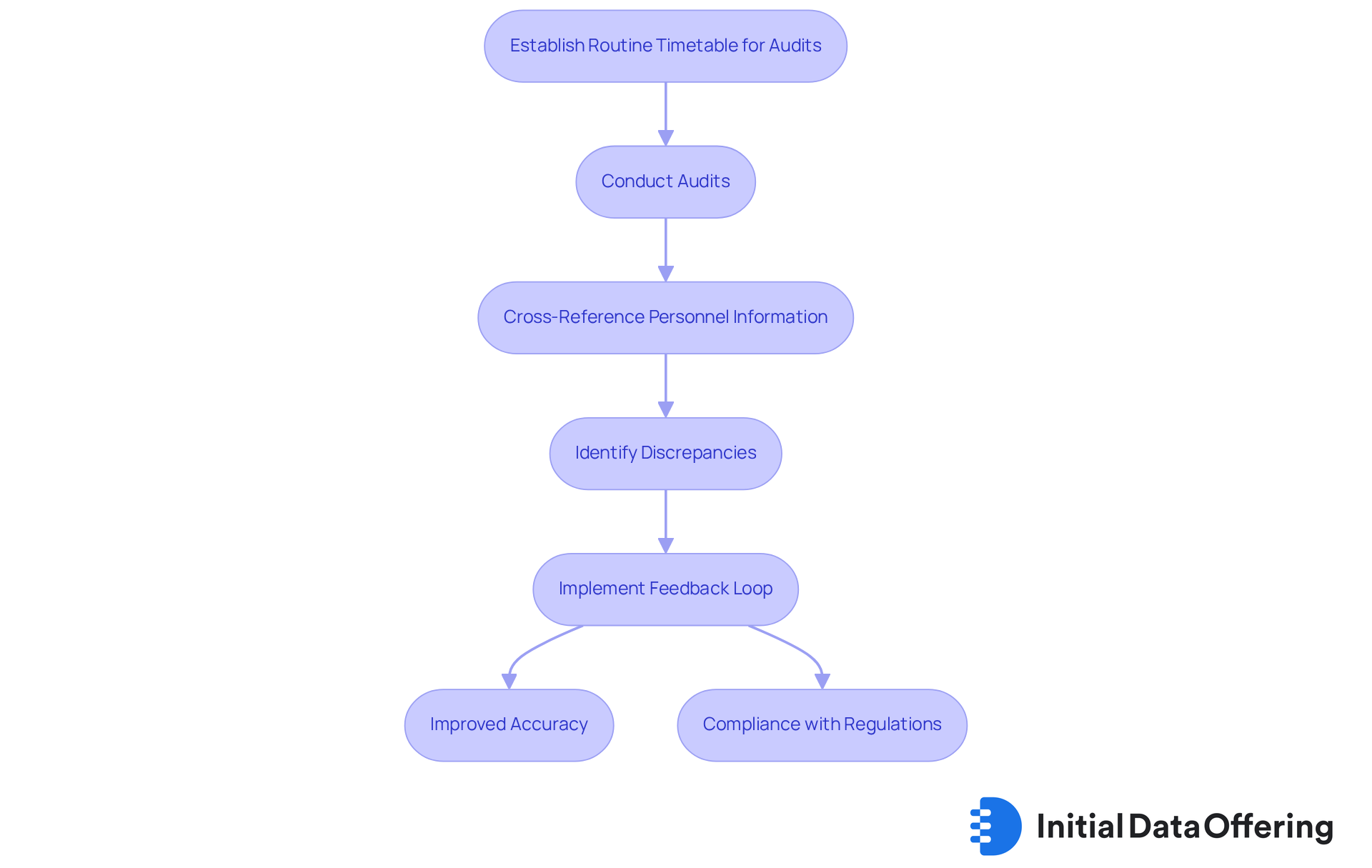4 Strategies for Effective Employee Data Management

4 Strategies for Effective Employee Data Management
Overview
The article outlines four essential strategies for effective employee data management, each of which plays a crucial role in enhancing organizational performance.
- Firstly, establishing clear standards for data accuracy ensures that the information utilized is reliable and relevant. This not only fosters trust within the organization but also enhances decision-making processes.
- Secondly, ensuring compliance with data protection regulations safeguards the organization against legal repercussions and builds credibility with employees and clients alike.
- Thirdly, leveraging technology for efficient data management allows for streamlined processes, reducing the time spent on data handling and increasing overall productivity.
- Lastly, conducting regular audits to maintain data integrity is vital; it identifies potential issues before they escalate, ensuring that the data remains accurate and trustworthy.
Each strategy is supported by practical examples and evidence demonstrating their impact on improving data quality, compliance, and operational efficiency. By implementing these structured approaches, organizations can manage employee information effectively, ultimately leading to better outcomes and enhanced organizational success.
Introduction
Effective employee data management is crucial in today's fast-paced business environment, where accuracy and compliance can significantly impact an organization. Companies are increasingly acknowledging the necessity of implementing robust strategies to streamline their data processes, ensuring that employee information is not only accurate but also secure.
However, with the complexities of data protection regulations and the rapid evolution of technology, how can organizations effectively navigate these challenges to enhance their data management practices? This article explores four essential strategies designed to empower businesses to improve their employee data management, drive efficiency, and maintain compliance in an ever-changing landscape.
Establish Clear Standards for Employee Data Accuracy
To ensure the precision of worker information, organizations must adopt standardized information entry protocols. This entails specifying particular formats for information fields, such as date formats and address structures, and offering thorough training for staff accountable for information entry. Implementing validation checks during information input is crucial for catching errors in real-time. For instance, using dropdown menus for job titles can effectively prevent misspellings. Regular updates to these standards, informed by feedback and evolving business needs, are essential for maintaining their relevance and effectiveness.
An important example is a prominent tech company that implemented a standardized information entry system, leading to an impressive 30% decrease in entry mistakes within the first quarter. This enhancement greatly increased the dependability of their HR analytics, showcasing the concrete advantages of standardization in employee data management. As highlighted by industry specialists, sustaining high information quality through standardized procedures is essential for informed decision-making and operational efficiency. Moreover, it is important to mention that 53% of procurement professionals assess their supplier information as inadequate, emphasizing the critical need for precision in information management. Techniques such as double entry can also be utilized to further ensure the integrity of information. Regular audits are essential to identify and correct discrepancies, reinforcing the importance of these standardized procedures.
As Gabrielle Laurene states, 'By implementing various techniques and practices, these specialists have the power to drastically enhance the precision of your information.

Ensure Compliance with Data Protection Regulations
Organizations must conduct a thorough examination of relevant privacy protection regulations to establish a robust compliance framework. This framework should feature clear policies regarding employee data management, including information collection, storage, and sharing, while explicitly defining staff rights concerning their personal information. Procedures for obtaining consent must be well-defined, ensuring both transparency and adherence to legal standards.
Frequent training sessions on information protection best practices are crucial for enhancing adherence among staff. For example, a multinational corporation implemented a dedicated compliance task force that performed quarterly audits to ensure GDPR adherence. This proactive approach not only mitigated potential risks but also cultivated a culture of privacy awareness throughout the organization. It enabled employees to understand and fulfill their responsibilities in information handling.
Additionally, organizations should be cognizant of the seven principles of protection outlined in Article 5.1-2 of the GDPR:
- Lawfulness
- Fairness
- Transparency
- Purpose limitation
- Minimization
- Accuracy
- Accountability
Integrating these principles into the compliance framework is essential for effective information management and protection.

Leverage Technology for Efficient Data Management
Investing in robust HR software solutions is essential for automating processes related to employee data management, including information collection, storage, and reporting. Key features such as cloud storage, data encryption, and user access controls enhance both data security and accessibility. Additionally, the implementation of AI-driven analytics provides valuable insights into staff performance and engagement trends, empowering organizations to make informed decisions.
For instance, InnovateX's integration of TechForing Human with its HR operations system led to a remarkable 50% reduction in administrative expenses. This shift allowed HR professionals to focus on strategic initiatives, streamlining operations and empowering staff through self-service capabilities. Similarly, Edgewell recognized the importance of information quality, achieving an accuracy rate of 96%-97% after implementing extensive oversight strategies, which included a dedicated quality initiative.
As the Head of HR at InnovateX stated, "We needed a solution that would not only streamline our HR operations but also empower our employees and enable data-driven decision-making." These advancements underscore the critical role of technology in optimizing employee data management and driving improved outcomes. However, organizations must also be mindful of common pitfalls in implementing AI-driven analytics, particularly regarding information quality and the need for transparency in AI decision-making processes.

Conduct Regular Audits to Maintain Data Integrity
Establishing a routine timetable for audits is crucial for ensuring accuracy, completeness, and adherence to established standards. These audits encompass cross-referencing personnel information with various sources, effectively identifying inconsistencies. Implementing a feedback loop that translates audit findings into actionable enhancements can significantly elevate the overall quality of information.
For example, a healthcare entity conducted bi-annual audits, revealing a 15% discrepancy in employee data management records. By promptly addressing these discrepancies in employee data management, they not only improved their information accuracy but also ensured compliance with stringent healthcare regulations. This proactive approach underscores the vital role of regular audits in fostering a culture of information integrity and adherence within organizations.
Furthermore, it is important to recognize that organizations can recover up to 3% of their overall pharmacy expenditures through specialized audit services, highlighting the financial benefits of maintaining rigorous information handling practices. As Dr. Michael Chang notes, a unified approach to data management is essential for crafting effective strategies that guarantee safer and more consistent outcomes.
How can your organization leverage these insights to enhance its audit processes?

Conclusion
Effective employee data management serves as both a necessity and a strategic advantage for organizations seeking to excel in a data-driven landscape. By establishing clear standards for data accuracy, ensuring compliance with data protection regulations, leveraging technology, and conducting regular audits, businesses can significantly enhance their data management practices. These strategies collectively lead to improved decision-making, operational efficiency, and a culture of accountability surrounding data handling.
This article has highlighted key strategies, including:
- The importance of standardized data entry protocols
- The establishment of a compliance framework aligned with legal requirements
- The integration of advanced technology solutions
- The necessity of routine audits to maintain data integrity
Real-world examples demonstrate how organizations have successfully implemented these practices, resulting in tangible benefits such as reduced errors and increased operational effectiveness.
As organizations look toward the future, embracing these best practices will be crucial for navigating the complexities of employee data management. The call to action is clear: prioritize the enhancement of data management strategies to cultivate a more secure, efficient, and reliable workforce management system. By doing so, organizations not only safeguard their data but also empower their teams to make informed decisions that drive success.
Frequently Asked Questions
What are the key standards for ensuring employee data accuracy?
Organizations must adopt standardized information entry protocols, specify formats for information fields, and provide thorough training for staff responsible for data entry.
Why is it important to implement validation checks during information input?
Validation checks are crucial for catching errors in real-time, which helps prevent mistakes and ensures the accuracy of employee data.
How can dropdown menus assist in improving data accuracy?
Dropdown menus for job titles can effectively prevent misspellings and other entry errors, contributing to higher data accuracy.
What impact did a tech company experience after implementing standardized information entry systems?
The tech company saw a 30% decrease in entry mistakes within the first quarter, significantly improving the reliability of their HR analytics.
Why is maintaining high information quality important for organizations?
High information quality is essential for informed decision-making and operational efficiency, as it directly impacts the reliability of data used in various processes.
What percentage of procurement professionals consider their supplier information inadequate?
53% of procurement professionals assess their supplier information as inadequate, highlighting the critical need for precision in information management.
What additional techniques can be used to ensure data integrity?
Techniques such as double entry can be utilized to further ensure the integrity of information.
How do regular audits contribute to data accuracy?
Regular audits help identify and correct discrepancies in data, reinforcing the importance of standardized procedures for maintaining data accuracy.